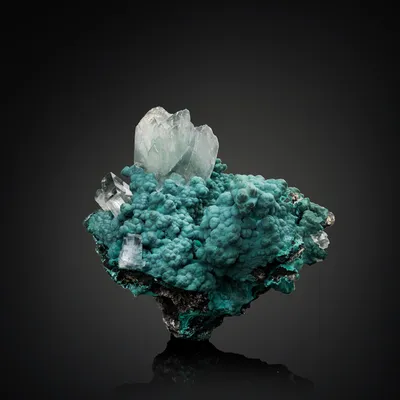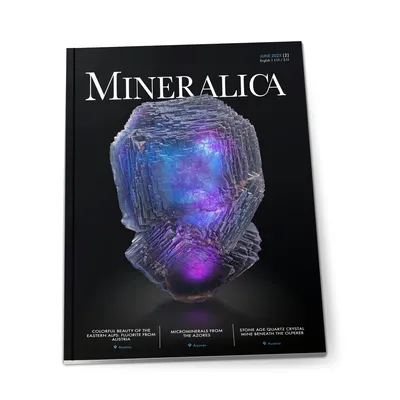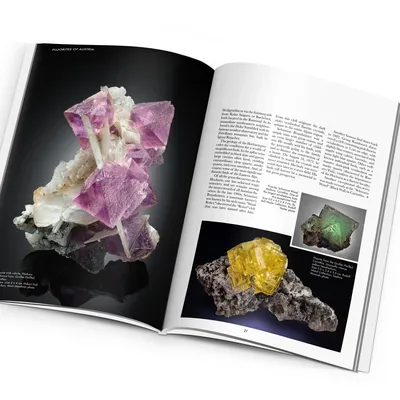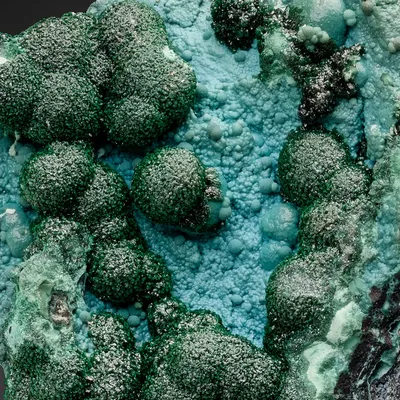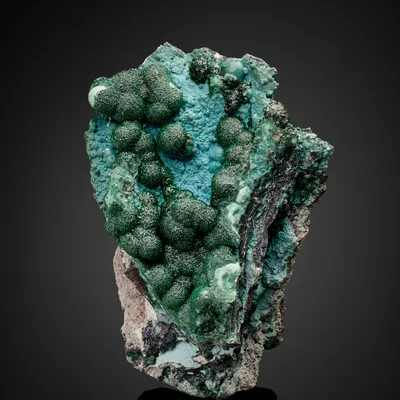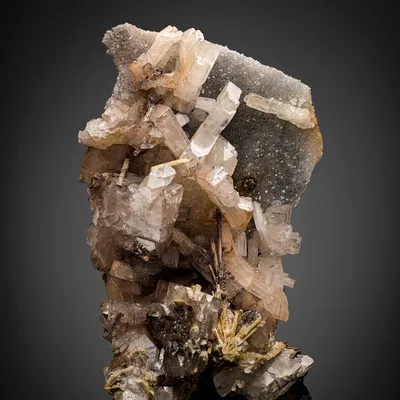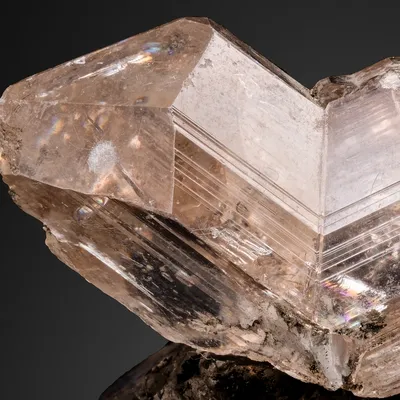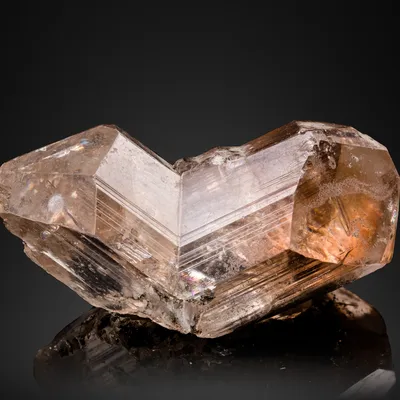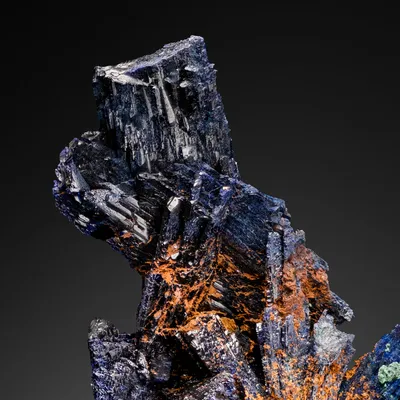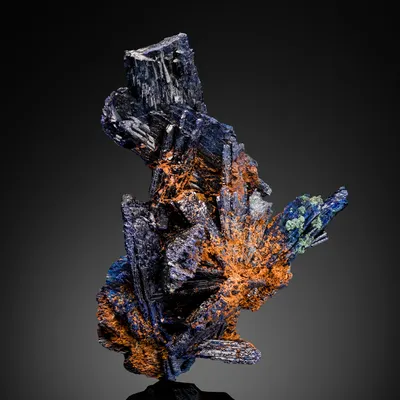The Long Life until Stability – Measuring Radioactive Quantities
About radioactive decay, half-life and interesting methods to make the invisible radiation visible.

Table of Contents
- The Decay
- The Half-Life – The Short or Long Life of Nuclides
- Decay Series Explained
- Decay Series in Nature
- Measuring Equipment for Radioactive Minerals
- Mathematical-statistical explanation
- Selfies of Radioactivity – Autoradiographs
- Gamma Nitrometry - Nuclide Determination for Mineral Collectors
- Recap
The Decay
Every radioactive decay is a statistical process. It is not possible to predict exactly when the decay will occur. A different number of decays can happen within a period of time. For measurements, this statistical character must be taken into account, i.e. each measurement is an individual measurement. The results vary within a certain range. For each measurement, the environmental radiation that is present everywhere, the so-called background, has to be measured first. The natural environmental radiation comes from the earth - called terrestrial radiation - or from the atmosphere and outer space - called cosmogenic radiation. Also, artificial sources contribute to the radioactive radiation that is present everywhere. The measurement of a radiation source is always a gross measurement, from which the environmental or background radiation must be subtracted in order to obtain the actual radiation of the source (net radiation).
...
It therefore makes sense to measure several times and calculate an average value, which is then taken as the most probable measured value. This statistical nature is discussed in more detail in the next chapter.
For the detection of radioactivity, fluorescence detection can be used in addition to measurements with a Geiger counter, e.g. for minerals or uranium glass. Many uranium minerals, and usually also uranium glass, are fluorescent in long-wave UV light of 365 nm or in black light of 395 nm. However, the fluorescence can be suppressed (quenched) by heavy elements such as copper in the minerals or in the color components. Nevertheless, the occurrence of fluorescence is not proof of the radioactivity a sample.
The Half-Life – The Short or Long Life of Nuclides
Nuclides are atomic nuclei, which are composed of protons and neutrons and represent a certain type of atom in the number of nuclides. They form minerals in different molecular compositions. Apart from their statistical nature, radioactive elements have another parameter that can be precisely determined: the half-life.
The half-life is the period of time in which half of the originally present radioactive parent nuclides have been transformed into child nuclides.
The half-life varies depending on the radioactive nuclide and can vary from fractions of a second to billions of years. The decay of nuclides is exponential. The half-life also provides an indication of the activity, i.e. the number of decays per second (1 Becquerel = 1 decay per second). Natural uranium has a radioactive activity of around 25,000 becquerels per gram of uranium.
The longer the half-life of a nuclide, the lower its activity. The shorter the half-life of a nuclide, the higher its activity.
Decay Series Explained
U-238, U-235 and Th-232 decay in several steps to the stable end state – they form decay series. The two most important are:
The noble gas radon is the main contributor to background radiogenic radiation. With its short-lived first radon descendants (framed in blue in the uranium-radium series), the danger of inhalation and storage in the lungs through dust, aerosols and silicosis, it contributes significantly to the health hazards of the general public.
Decay Series in Nature
There are more than 340 different uranium minerals in nature. On a global average, one ton of rock contains 2-4 grams of uranium. This means that uranium is as common as tin, but 500 times more common than gold. The uranium minerals are mostly yellow, but also green and orange in color. Many of these colorful minerals show fluorescence when exposed to short-wave UV light of 360 nm, but also when exposed to black light of 396 nm. Pitchblende (uraninite as a mineral) is the most economically important uranium mineral. It is a uranium oxide, idealized UO2, depending on the deposit essentially U3O8. Most other uranium minerals are derived from pitchblende. Autunite Ca(UO2)2(PO4)2·10-12H2O, uranocircite Ba[UO2|PO4]2·10H2O, torbernite Cu[UO2|PO4]2·12H2O and zeunerite Cu[UO2|AsO4]2·10–12H2O are common. All uranium minerals contain the decay products of the U-238 series and, to a much lesser extent, those of the U-235 series.
Thorium is found in the earth's crust at a frequency of 7–13 milligrams per kilogram, making it twice to three times more common than uranium. As of 2024, 56 thorium minerals are known. Common thorium minerals are thorianite and thorite. However, thorium occurs in accessory form in other minerals, such as monazite, titanite and zircon. Monazite and zircon are components of heavy mineral sands that can be obtained, for example, from gold panning.
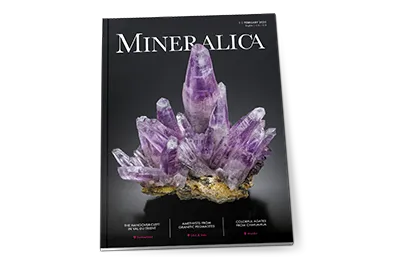
The new premium magazine for mineral collectors
4 issues per year – packed with fascinating finds, expert knowledge, and collector passion. The first bilingual magazine (German/English), including full online access.
Explore subscriptionMeasuring Equipment for Radioactive Minerals
The author recommends a Geiger-Müller end-window counter tube with a 4.5 cm detector diameter, alpha-, beta- and gamma-sensitive with time settings for measurements. The Inspector (no longer manufactured, possibly still available second-hand), Ranger (successor to the Inspecrtor) and GMC600+ measuring devices are still on the market. Preselectable measuring times are useful for the measurement. The pancake counter tube is used to measure the pulses for the sum of alpha, beta and gamma radiation per time unit. These measuring devices are only suitable for dose rate measurements to a limited extent, as high-energy gamma radiation is not recorded. A gamma measuring device that is as accurate as possible is therefore recommended in order to ensure a permissible dose rate of 1 µSv/h at a distance of 10 cm to the radioactive samples. The GQ GMC 320+ measuring device, which is discussed in the article Methods of Field Collecting Radioactive Minerals by Sean Price, is suitable for this purpose. More detailed data can be found in the description of the measuring device. The Inspector and Ranger end window counter tubes are protected by a metal grid. However, the window should not be placed on sharp objects that could damage the window by pushing through the grid. Cleaning with high-pressure compressed air should also be avoided. If the window breaks - or even if there is a hairline crack - it will become inoperable and the counter tube must be replaced. The use of polystyrene spacer masks, in the size of the device with the detector window in the correct position, helps to protect the meter.
One minute is a suitable measuring time for most uranium minerals. A practical measuring window cover is available for the Ranger. A 2 mm thick aluminum disk fits into it so that only gamma radiation is measured. Alternatively, a 1 mm thick lead disk can be used so that high-energy gamma radiation is shielded to such an extent that it can be detected by the detector. Practical rubber sheaths are available for the Inspector and the Ranger; a stand is also available for the Ranger.
Mathematical-statistical explanation
Decay rates in radioactivity are statistical quantities. In order to obtain significant conclusions, the following considerations must be taken into account.
The decay law applies to radioactive decay in the time-dependent form:
N(t) = N0⋅e-k⋅t
Where N0 is the number of atomic nuclei present at time t = 0, N(t) is the number of nuclei present after time t has elapsed, T1/2 is the half-life of the isotope in question and k is the decay constant (decay probability) with
k = In 2 : T1/2
This decay law only applies numerically if the number of decaying radioactive atoms is high. It also applies if the number N is replaced by the activity A or the mass m. In order to obtain a count rate value with a reliable statement due to the statistical nature of the measurements, several measurements must therefore be carried out and an average value calculated. If only one measurement is taken, the measured count rate can be particularly low or particularly high. The count rates are only integer and non-negative. The possible interval of a distribution is described by the standard deviation (in physics also standard measurement uncertainty) s. 68.3% of the measured values lie within an interval of ±s, 95.6% within an interval of ±2s and 99.7% within an interval of ±3s. The standard deviation is obtained as a very good approximation for a high number of measurements from the square root of the mean value of the measurement:
s = √xm
Where xm is the average of the measured values.
Selfies of Radioactivity – Autoradiographs
The discovery of radioactivity began with an autoradiograph of a uranium mineral by Antoine Becquerel. Dental films “Ergonom X” self-developing X-ray films without developing equipment are available on the Internet and are used by dentists, for example. After the image has been taken, the X-ray films can be fully developed without additional developing equipment. The X-ray film is exposed as usual with a radiation source.
The films are 3 cm x 4 cm in size and can be developed quickly and easily without a developing device or darkroom using the enclosed utensils. A description is enclosed with the films.
In the case of stone, you should work with a polish. For mineral specimens, make sure that the surface on which the film is placed is as flat and smooth as possible. The film should be fixed to the object with adhesive tape and lie as flat as possible. In the example shown, a sample from the Svornost mine in Jáchymov Lazné/St. Joachimsthal in the Czech Republic was used. The polished section already clearly shows the deep black areas with pitch blinding. The film must be positioned in such a way that areas without radioactivity are also covered. The development time varies depending on the pulse rate of the object; if necessary, test exposures should be taken with varying times. A short exposure time of 18 hours was successful with very strong, radioactive samples such as the one shown. After exposure, the film is developed according to the instructions. The exposed stage can be photographed and the negative can be scanned and projected.
Gamma Nitrometry - Nuclide Determination for Mineral Collectors
In recent years, many devices have been improved, which has also made them cheaper. This makes it possible to carry out investigations that mineral collectors could not previously imagine or afford. Gamma spectrometers measure the dose rate of gamma radiation and certain (discrete) energies characteristic of the respective radionuclide. This can be used to determine nuclides. Sean Price introduced the Radiacode 102 for this purpose. This device is still manufactured in Belarus and delivered to Western countries via indirect routes. A European alternative is the Raysid, a Polish device with European guarantee.
The support from the manufacturer in Poland is very good; communication is in English; warranty issues or repairs are very rare, but are carried out quickly and without any problems. The Raysid is supplied with a telescopic holder, which can also be used to reach the ground or higher objects. To view the spectrum of the gamma rays, there is an app for the smartphone that connects to the Raysid via Bluetooth. The Raysid has GPS so that all measurements can be determined and recorded depending on the location. This GPS data can be entered into a map that is accessible to all Raysid owners.
Recap
A combination of Ranger and Raysid would be ideal for ambitious collectors of radioactive minerals. The price for the Ranger is 1200 €, for the Raysid 700 €. This should only be purchased, if at all, if you are interested in radioactive minerals on a long-term and in-depth basis. An alternative to the Ranger is the GQ GMC600+, which is priced at €450. Used devices are very rarely offered. However, the device is very robust and was used in the former Yugoslavia to detect uranium ammunition. If you do not want a spectrometer, the GQ GMC320+ with a price of approx. 130 € is usually sufficient (all prices as of May 2024), which can also detect radiation.
The Ludlum devices are professional devices. They are available second-hand on the US market (price range €400 to €600), but prices have risen sharply in recent years. Shipping usually costs over €100, plus VAT and customs import fees may apply.
References
- EIGLER, G., GEIPEL, R., PASCHER, G., KLINGER, J., MICHL, H.: Über die Radioaktivität, Geschichte und Bedeutung, die bayerischen Uranminerale, das böhmische Erzgebirge und die Bergstadt St. Joachimsthal/Jáchymov. 306 S., Stadtmuseum Nittenau, Nittenau 2009 (vergriffen)
- GEIPEL, R.: Schul- und Praktikumsversuche mit natürlicher Radioaktivität, Teil 1. Strahlenschutz Praxis 13. Jahrgang 2007, Heft 1/2007
- GEIPEL, R.: Schul- und Praktikumsversuche mit natürlicher Radioaktivität, Teil 2. Strahlenschutz Praxis 13. Jahrgang 2007, Heft 2/2007
- GEIPEL, R.: Von Bequerel, Antoine zum Becquerel, Regensburg 1998, Vortrag und Skript aus Lehrerfortbildungen, kostenloser Download über www.radioaktivitaet-zum-anfassen.com
- GEIPEL, R. & PHILIPSBORN, H.: Uranvererzungen in Aufschlüssen des Nabburger Flussspatreviers – Probleme der Umweltradioaktivität und der Strahlungsmessung, aus Aufschlüsse zur Erdgeschichte Bayerns, Sonderheft VFMG-Sommertagung Amberg 2000 (S. 49 – S. 58)
- GRAMMACCIOLI, D.M.: Conoscere i Minerali – I – Radioattivi , Istituto Geografico Agostini, 1985 (96 S.)
- HOCHLEITNER, R., PHILIPSBORN, H. VON, WEINER, K.L. & RAPP, K.: Minerale – Bestimmen nach äußeren Kennzeichen, 3. Aufl. Schweizerbartsche Verlagsbuchhandlung, Stuttgart 1996 (390 S)
- PHILIPSBORN, H. VON: Uranminerale in Sammlungen. Aufschluss 46, Heidelberg 1999 (S. 123 – S. 131).
- PHILIPSBORN, H. VON: Zum Sammeln radioaktiver Minerale. – Lapis, 21, Heft 3 München 1996 (S. 29 – S. 35)
- PHILIPSBORN, H. VON & GEIPEL, R. (1999): Neuartige Schul- und Praktikumsexperimente. Physikalische Blätter 55 1999 (S. 67 – S. 69)
- PHILIPSBORN, H. VON & GEIPEL, R.: Teaching Radon in the Living Environment. Poster
- PHILIPSBORN, H. VON & GEIPEL, R.: Uraniferous Granites – Characterized by their Radon Exhalation. Posterpräsentation Deutsche Mineralogische Gesellschaft J Magyarhoni Földtani Társulat Österreichische Mineralogische Gesellschaft, Wien, 1999
- PHILIPSBORN, H. VON & GEIPEL, R.: Naturally Occuring Radioactive Materials and Radiation Protection. In D. RAMMELMAIR et al. editors: Applied Mineralogy Proceedings, 6th Intern, Congress of Applied Mineralogy Göttingen 2000, Vol. 2, Rotterdam 2000 (S. 697 – S. 700)
- PHILIPSBORN, H. VON, GEIPEL, R.: Was müssen Mineralogen von Radioaktivität wissen, Posterpräsentation zur 78. Jahrestagung der Deutschen Mineralogischen Gesellschaft in Heidelberg 2000, European Journal of Mineralogy Vol. 12, 2000
- PHILIPSBORN, H. VON & GEIPEL, R.: Strahlenschutz. Radioaktivität und Strahlungsmessung. Bayerisches Staatsministerium für Umwelt, Gesundheit und Verbraucherschutz, 8. überarb. Aufl. 2006 (234 S.). www.gesundheit.bayern.de.
- PHILIPSBORN, H. VON, GEIPEL, R. & JUST, G. : Radon Exhalation aus Baustoffen – ein Beitrag zur Metrologie im Strahlenschutz.
- – Vortrag 12. Statusgespräch BMU
- – Forschung zum Problemkreis Radon
- WINTER, I., PHILIPSBORN, H. VON: Ethanol als Radonspeicher. Anwendungen in der Mess-technik. Strahlenschutzpraxis Heft 4, 1997, S. 68 – S. 70)




















